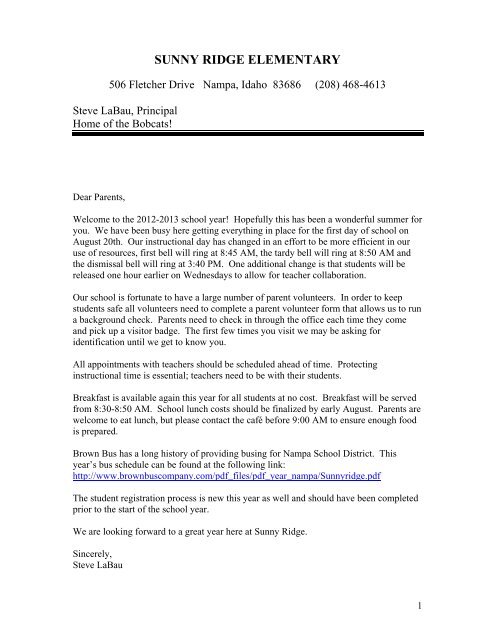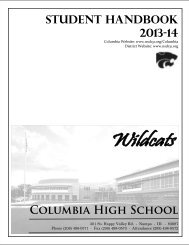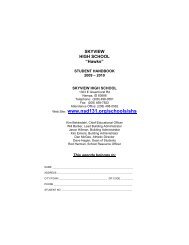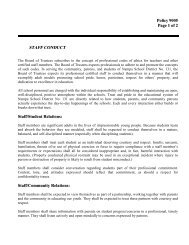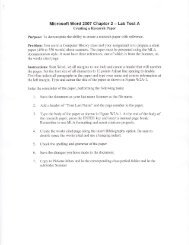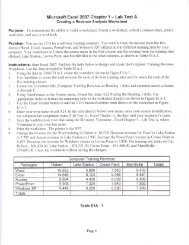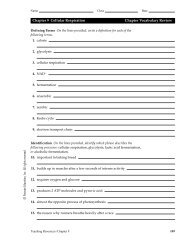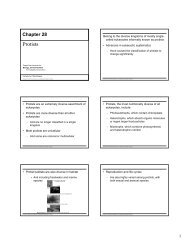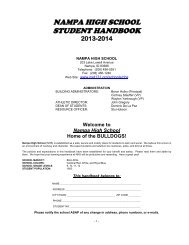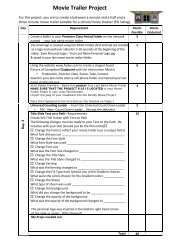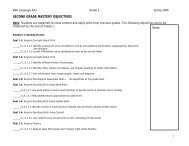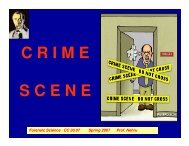SUNNY RIDGE ELEMENTARY - Nampa School District #131
SUNNY RIDGE ELEMENTARY - Nampa School District #131
SUNNY RIDGE ELEMENTARY - Nampa School District #131
Create successful ePaper yourself
Turn your PDF publications into a flip-book with our unique Google optimized e-Paper software.
<strong>SUNNY</strong> <strong>RIDGE</strong> <strong>ELEMENTARY</strong>506 Fletcher Drive <strong>Nampa</strong>, Idaho 83686 (208) 468-4613Steve LaBau, PrincipalHome of the Bobcats!Dear Parents,Welcome to the 2012-2013 school year! Hopefully this has been a wonderful summer foryou. We have been busy here getting everything in place for the first day of school onAugust 20th. Our instructional day has changed in an effort to be more efficient in ouruse of resources, first bell will ring at 8:45 AM, the tardy bell will ring at 8:50 AM andthe dismissal bell will ring at 3:40 PM. One additional change is that students will bereleased one hour earlier on Wednesdays to allow for teacher collaboration.Our school is fortunate to have a large number of parent volunteers. In order to keepstudents safe all volunteers need to complete a parent volunteer form that allows us to runa background check. Parents need to check in through the office each time they comeand pick up a visitor badge. The first few times you visit we may be asking foridentification until we get to know you.All appointments with teachers should be scheduled ahead of time. Protectinginstructional time is essential; teachers need to be with their students.Breakfast is available again this year for all students at no cost. Breakfast will be servedfrom 8:30-8:50 AM. <strong>School</strong> lunch costs should be finalized by early August. Parents arewelcome to eat lunch, but please contact the café before 9:00 AM to ensure enough foodis prepared.Brown Bus has a long history of providing busing for <strong>Nampa</strong> <strong>School</strong> <strong>District</strong>. Thisyear’s bus schedule can be found at the following link:http://www.brownbuscompany.com/pdf_files/pdf_year_nampa/Sunnyridge.pdfThe student registration process is new this year as well and should have been completedprior to the start of the school year.We are looking forward to a great year here at Sunny Ridge.Sincerely,Steve LaBau1
Sunny Ridge Elementary <strong>School</strong> Polices(Please also review our district elementary policies on our website at:www.nsd131.org/sunnyridge.)Welcome to Sunny Ridge!Our administration and staff is dedicated to the success of all children in our school. We realize that toachieve this goal, we must partner with parents, recognizing that the parent is truly the child’s first andmost important teacher. We invite parents to communicate openly with us as we work together toprovide the best possible educational program and to visit and work within our school. Last year ourvolunteer parents/guardians spent countless hours assisting in classrooms and with projects and activitieshere at Sunny Ridge. In addition to volunteering, we urge parents to take an active role in their child’seducation by discussing with your child what was learned at school daily, and by providing space, timeand support for homework. It is also vital to read daily with or to your child—at least 20 minutes per day.We will, in turn, strive to provide the best learning environment and best instruction possible. Workingtogether, we will help ensure that all children experience success as learners. Please click onhttp://www.nsd131.org/admin/nclb/ to learn more about our school.Assets—Character VirtuesOur school has identified Six Pillars of Character: responsibility, respect, trustworthiness, fairness, caringand citizenship. Each month one of the character virtues is a focus and students are recognized for theirefforts in demonstrating the trait.Birthdays and Class TreatsBirthdays are an important day for a child and Sunny Ridge recognizes birthdays with a treat and abirthday song. We also have three classroom parties a year celebrated at: Thanksgiving, Christmas, andValentine’s Day.Party treats should be store bought. Please be aware of your child’s classroom needs when selecting atreat. Ideal items for any classroom are individually wrapped treats like Hostess or Little Debbie snackcakes, fruit snacks or fruit rollups, packaged cookies, individual wrapped packages of crackers or snackfood, or healthful snacks such as carrot sticks or apple slices. Please do not send drinks. Treats can beleft at the office; the teacher will serve it at a convenient time during the day that minimizes lostinstructional time. In some cases the teachers may decide to recognize birthdays at a specific time or on aspecific day during the week or month.Notice: Due to hurt feelings, party invitations of any kind will NOT be distributed at school. Flowers orballoons will not be delivered to the classroom until the end of the school day and are NOT allowed on thebus.Before and After <strong>School</strong>We are concerned about student safety and do not want children on the playground unsupervised.Students may come on the playground after 8:30 a.m., or they may go through the café doors to go tobreakfast. Students are expected to enter the building from the playground, not the front doors of theschool unless they are tardy. If tardy, children must come to the office to sign in and receive a tardy pass.Students are expected to exit the building and school grounds by the established exit route and not lingeron the school grounds after school is released.2
Food, Drink & GumFood and drink are allowed only in the cafeteria unless approved by a teacher or administrator. Gum isnot allowed in the building, on the playground or on the bus without administrative approval. Studentsare discouraged from bringing soda pop or energy drinks to school with their lunch.FundraisingOur PTA organization will sponsor up to two fundraisers a year and our annual carnival. For the safety ofall children no door to door sales are allowed. Please check our school website to contact our PTA officersand for more information.Hall PassesHall Passes are required of all students when they are out of their assigned class. Students without hallpasses will be escorted back to class.Library BooksLibrary books are checked out to students and may be taken home. Students are responsible to pay forlost and/or damaged books.Literacy – FluencyLiteracy is our top academic priority. Comprehension is the essence of reading and to gaincomprehension there are multiple skills that are foundational, beginning long before a child attendsschool. Our Open Court reading series is a research‐based, systematic program that builds essential skillsto produce a quality reader. There are skills, though, that some students need more intensive time andinstruction in order to develop. Those skills include basic phonological awareness, print concepts, oralvocabulary, letter development, and reading fluency. The National Research Council Report states thatthe ability to obtain meaning from print is heavily dependent upon reading fluency. Fluency meanssufficient rate and accuracy while reading. As students move into the upper grades, the reading textbecomes more difficult and lengthy. If a reader is not fluent, i.e. stumbles on pronunciations or is choppyin his/her reading, comprehension becomes compromised and reading for meaning is lost. The followingchart provides you with appropriate words per minute for each grade level needed in order to keep areader on target for quality reading and comprehension,Lost and FoundSpring Words per Minute:1 st grade: 542 nd grade: 923 rd grade 1104 th grade: 1405 th grade: 150Please mark your child’s property (lunch boxes, backpacks, coats, hats and gloves) with their name. Checkthe lost and found periodically for missing items. Items that are left in the Lost and Found are donated tolocal charities at the end of the year.Parent Teacher AssociationAll parents, staff, and students are invited to join our PTA at Sunny Ridge Elementary. We will meetapproximately once a month. We encourage you to join and participate in activities throughout theschool year. To get involved, please contact the school office for the PTA‐Booster Club officers’ phonenumbers.4
<strong>School</strong>‐wide RulesKeep hands, feet, body and objects to yourselfRespect people, property and the learning environmentsArrive to school and class on time prepared and ready to learnBe courteous during passing times and in interactions with other students and staffResolve differences amicably and with positive intentionsSeek help from staff in difficult situationsDress appropriately for a positive and safe learning environmentTreat our campus and school property with respectFollow rules established for a variety of activities on and off our campusesFollow directions from all staffVolunteersWe welcome and encourage you to volunteer. Volunteers can help in a variety of ways including listeningto a child read, tutoring, updating bulletin boards, serving on our site improvement team, supervising fieldtrips or helping with the many other tasks. Please contact your child’s teacher, any staff member or a PTAOfficer if you can help. A volunteer ID and sign in book are in the school office. All volunteers need tocomplete a short questionnaire and background check5
Revised June 2012Attendance/Absences/TardiesOur district’s elementary policies 2012‐13(Please also review our school’s unique policies.)Students should be in school every day to be successful. Students who are frequently absent from schooloften fall behind academically and can struggle. <strong>Nampa</strong> school board policy states:“All children of compulsory attendance ages (7‐16) are required to attend school. Attendance andpunctuality are important elements of the educational process for all students. Therefore, all enrolled K‐12 students are expected to be in school 100% of the time classes are in session, unless they areparticipating in school‐related activities otherwise excused by <strong>School</strong> Board Policy or Idaho State Law.”If your child will be absent from school, please call the school before 9 a.m. If we don’t hear from you, weare obligated to verify the absence. If you are having trouble getting your child to school on time, pleasecontact us so we can identify resources that may help.If your child has missed 5 days, the school will contact you; 7 days will result in a letter or phone call toschedule a conference with you; and if your child misses 10 days of school, the student will be referred tothe <strong>School</strong> Resource Officer to identify the next steps on truancy. Excessive tardies will be addressed bythe administration as well.Students will have two days for every excused day missed to make up work. It is the student’sresponsibility to request make‐up work. When a student has had an excused absence for threeconsecutive days, the parent may request make‐up work be sent to the office to pick up. Requested workwill be available by end of the next school day.Bicycles, Scooters, Skateboards, RollerbladesStudents are welcome to use bicycles, scooters, skateboards or rollerblades to ride to school. Once thestudent arrives at school the bicycles, scooters, skateboards or rollerblades need to be immediatelysecured on bike racks or in designated locations. For their safety and to reduce wear and tear on schoolfacilities, students wearing heelies (rollerskating tennis shoes) will be asked to lower or remove thewheels. We cannot replace lost or stolen items, so please use a lock.BullyingOur school is committed to providing a safe learning environment for students. This includes identifyingand taking steps to prevent bullying among our students. Bullying occurs when a child is exposed,repeatedly and over time, to negative actions on the part of one or more children. Bullies want the victimsto feel: hurt, sad, mad, scared, or embarrassed. Bullying behaviors include, but are not limited to:Physical: kicking, shoving, hair pulling, hitting, slapping, biting, tripping, stealing, spitting, or damagingpeople’s possessions;Verbal: name calling, taunting, put downs, teasing, threats, rumors, sarcasm, gossiping, ethnic slurs,or betraying a confidence;Emotional: mocking, laughing, imitating, rejecting, humiliation, excluding, social isolation, writingnotes, emails, text messages, dirty looks, or hand signs.Cyber: tormenting, threatening, harassing, humiliating, or embarrassing by using the Internet,interactive and digital technologies or other electronic devices or computers at school.If you believe your child is being bullied, please contact us immediately.1
Revised June 2012Math – Envisions Math was adopted by the district in 2009‐10. This is a daily problem‐based interactivemath learning program. It provides tools for the teacher to identify areas where students may struggleand help them improve. The curriculum also addresses the needs of advanced students.Science – Houghton Mifflin Science was adopted by the district in 2008‐09. This program provides: Handsoninquiry‐based lessons, readable standards‐based content, connections to reading, vocabulary, andwriting standards, solid instruction to reach every learner, and multiple ongoing assessments to preparestudents for test success.Social Studies – Grades 3‐5 – Please talk with your child’s teacher about the instructional materials usedto meet state standards in this content area.Dress CodeWe ask for your support in providing a safe and orderly place where all children can learn. The purpose ofthe Dress Code is to encourage students to “dress for success” and to come to school prepared to learn.Students should be well groomed and dressed in clothing that is appropriate to the learning environmentand weather conditions. Students are not allowed to wear clothing that constitutes a health or safetyhazard or is disruptive to the educational process.Dress Code guidelines: Shoes must be worn at all times. Students should wear shoes appropriate for PE and outdoorplay. Articles of clothing that advertise or promote drugs, alcohol, tobacco, violent acts, or aredemeaning, degrading or offensive to any person are not appropriate. Any clothing or paraphernalia that may be construed as gang or violence related including hats,bandanas, colors, sags, chains, etc. is inappropriate. Modest clothing is appropriate for school wear. Hats or headwear may be worn for bad weather or for medical reasons but are inappropriateinside the school building. Hats may be permitted during special occasions approved by theschool. Inappropriate skin art that disrupts the learning environment such as tattoos, temporary tattoos,etc. must be covered or removed.Field TripsState funding and district funding for field trips has been eliminated. We may be able to offer field tripswith grants and other money from fund raisers. Students will bring home notification and permission slipsfor field trips off site. Students are not allowed to have other student visitors or siblings accompanythem. A limited number of parent chaperones usually are requested. Contact your child’s teacher formore information.Gangs & Hate GroupsWe have a zero tolerance policy for gangs, hate groups, and similar organizations or groups, whichadvocate hatred or discrimination on the basis of race, color, religion, sex, ancestry, national origin, orhandicap. These groups are inconsistent with the fundamental values and educational environment atour school. The activities of such groups and their members are prohibited on school property and at allschool functions. Such prohibited activities include, but are not limited to:The congregation of members that block building entrances, hallways, or otherwise disrupts campus;The solicitation or recruitment of members;The possession of group paraphernalia and materials;3
Revised June 2012The intimidation of others;The advocacy of discrimination; andAny other behavior, (such as wearing clothing with gang colors or insignia, or the use of language,codes, or gestures) that provokes violence or seeks to advocate the purpose and objectives of suchgroups.Disciplinary actions may include suspension, expulsion, and/or police involvement.GradingReport cards will be sent home three times a year. Parent conferences will be scheduled twice a year.Please see our calendar in this handbook or at www.nsd131.org for dates. We encourage you to set upadditional teacher conferences as needed.Head LiceBecause head lice (pediculosis) are easily spread between students, it may be necessary to exclude astudent found to have head lice including the presence of nits (eggs.) To control head lice, the followingmeasures will be taken:A student suspected of having lice will be referred to the school office for inspection by theschool nurse or other school official. If head lice or nits are found, the child may be sent homewith a note to his/her parent/guardian explaining the condition and recommendations fortreatment.After the child has been treated, he/she should be inspected at the school office and if the childis lice‐free, he/she will be readmitted to class.Close contacts and friends of the initial case may also be examined for head lice and nits. If anycases are identified, they may be sent home as described above. Other students in the schoolmay be examined at the discretion of the building administrator and the school nurse.In situations where a student has a chronic head lice problem, the school nurse may need tocontact the family, possibly making a home visit to instruct them in appropriate treatment andresources. It also may be necessary for the Department of Health and Welfare and the <strong>School</strong>Resource Officer to be contacted in chronic cases.Health/IllnessesThe health of your child is important. If your child suffers from a chronic condition such as asthma pleaselet us know when registering your child. During the school year, if your child contracts anythingcontagious please let the school nurse know. A child should not attend school if he/she has any of thefollowing:Temperature of 100 degrees or moreVomiting or diarrheaNasal discharge of yellow/green colorCough in combination with any of the aboveAny other contagious conditions including conjunctivitis, head lice, etc.An unidentified rash4
Revised June 2012Homeless familiesIf your family lives in any of the following situations:In a shelter, motel, vehicle, or campgroundOn the streetUnaccompanied youthFoster familyIn an abandoned building, trailer, or other inadequate accommodations, orDoubled up with friends or relatives because you cannot find or afford housingThen, your preschool‐aged and school‐aged children have certain rights or protections under the federalMcKinney‐Vento Homeless Education Assistance Act.Your children have the right to:Go to school, no matter where you live or how long you have lived there. They must be givenaccess to the same public education, including preschool education, provided to other children.Continue in the school they attended before you became homeless or the school they lastattended, if that is your choice and is feasible. If a school sends your child to a school other thanthe one you request, the school must provide you with a written explanation and offer you theright to appeal the decision.Receive transportation to the school they attended before your family became homeless or theschool they last attended, if you or a guardian requests such transportation.Attend a school and participate in school programs with children who are not homeless. Childrencannot be separated from the regular school program because they are homeless.Enroll in school without giving a permanent address. <strong>School</strong>s cannot require proof of residencythat might prevent or delay school enrollment.Enroll and attend classes while the school arranges for the transfer of school and immunizationrecords or any other documents required for enrollment.Enroll and attend classes in the school of your choice even while the school and you seek toresolve a dispute over enrolling your children.Receive the same special programs and services, if needed, as provided to all other childrenserved in these programs.Receive transportation to school and to school programs.When you move, you should do the following:Contact the school district’s local liaison for homeless education for help in enrolling your child ina new school or arranging for your child to continue in his or her former school. (Or, someone ata shelter, social services office, or the school can direct you to the person you need to contact.)Contact the school and provide any information you think will assist the teachers in helping yourchild adjust to new circumstances.Ask the local liaison for homeless education, the shelter provider, or a social worker forassistance with clothing and supplies, if needed.Home/<strong>School</strong> CommunicationsIt is essential for the school to have your current contact information ‐ home phone, cell phone, workphone, home address, and email ‐ so we may contact you in emergencies and send you importantinformation. Please update the school immediately when your contact information changes.5
Revised June 2012Keeping you informed – We want to keep you updated about your child’s progress and of schoolevents. Please check your email for information. We will also send notes, papers, and otherinformation home often so please check your child’s backpack/folder regularly. We’ll shareevents and news about our school on our website, class newsletters, informational notes andcalendar. We use ParentLink – an automated telephone message system – to call/textinformation during the year.Monitoring student progress, attendance – Our district and school use a student informationsystem called Power<strong>School</strong> to provide access to attendance and grades. Please check at theschool’s main office to see which grade levels use this tool and how you may sign up for apassword to access this program.Answering your questions – Your concerns are important. We invite you to contact your child’steacher or our school administration by note, phone message, or by e‐mail. Email is the fastestway to reach a teacher or administrator. If you need an email address please visit our website orcall the office. We also welcome face‐to‐face discussions; however, we ask that you make anappointment prior to visiting because administrators and teachers are working with studentsduring the school day.Delivering messages – Our goal is to provide uninterrupted learning time for your child. Becauseof this, we will only interrupt a child learning for emergency phone messages. We know thatoccasionally a nonemergency message is necessary; we ask that you contact us no later than 30minutes prior to the end of school. This provides time to locate your student.Working together – Federal law requires that we develop a <strong>School</strong>/Parent/Student Compact thatemphasizes the responsibilities of students, parents, and schools to support each other. Eachyear, we ask that you please review the <strong>School</strong>/Parent/Student Compact with your child. Bysigning this compact, you are agreeing to take responsibility to help your child/children to learnin the best way possible and open the lines of communication between school and home.ImmunizationsIdaho State Law requires a parent/guardian of any child who is to attend any public, private, or parochialschool in Idaho to provide proof of required immunizations before attendance; children who are not incompliance may not enroll. There is a waiver available for personal or medical reasons which can beobtained upon request. Children will not be allowed to attend school if the requirements are not met or awaiver is not on file. Please contact your family physician or the school nurse if you have any questions.The following are required immunizations for children entering school:Children born between Sept. 1, 1999 and Sept. 1, 2005 need:5 DTaP (unless the 4 th dose was after their 4 th birthday)2 MMR3 Polio3 Hepatitis BChildren born after Sept. 1, 2005:5 DTaP (unless 4 th dose was after their 4 th birthday)2 MMR4 Polio (unless the 3 rd dose was after their 4 th birthday AND at least 6 months between dose 2 and 3)3 Hepatitis B2 Varicella (Chicken pox) (unless the disease is documented by a physician)2 Hepatitis AParents must submit a record of their child’s immunization status to the school upon enrollment.6
Revised June 2012InjuryThe school staff can provide simple First Aid; however, if your child becomes ill or injured at school, wewill contact you to pick him or her up. Please ensure we have the most current home and day‐timetelephone number for you and for two emergency contact persons. In emergencies, when parentscannot be reached, the school will call the paramedics. The cost of transport by paramedics and/orambulance will be the responsibility of the parents (see insurance).InsuranceEven with the greatest precautions and the closest supervision, accidents can and do happen at school.The school district does not provide medical insurance to automatically pay for medical expenses whenstudents are injured at school. This is the responsibility of the parent/guardian. Inexpensive studentmedical insurance is available for individual purchase. Brochures outlining the coverage and premiums areavailable at the school office. For information about other programs available contact the school nurse.Medication PolicyMedication should be taken at home. However, if a child is to take prescription medication during schoolhours, an “Authorization to Administer Medication” form must be submitted to the school office. Formsare available at the school office. The form needs to be signed by the doctor and a parent or guardian.Also, an updated authorization form will be required each time a change is made in the prescription.Asthma multi‐dose inhalers may be carried by the student, with the written permission of student’sphysician and parent. Non‐prescription medication may only be given to elementary students per nursingjudgment and parent/guardian permission. A written release must be on file and show: medicationname, strength, reason/instructions, dosage time to be administered, parent and physician signatures.This applies to all medications.Medication must be delivered to school by the parent. The medication must be in the original containerwith specific instructions for administration. No more than one week’s supply is to be brought to school.All medication will be kept in a secure area in the school office. Medication will not be kept in theclassroom. This includes inhalers, except as noted above.Parental InvolvementParent involvement is an essential component for your child’s success in school. We welcome andencourage your involvement in your child’s education and our school. Also because we receive federalTitle I funds, our school must meet specific requirements in this area. Below is what we must do inplanning, holding an annual meeting, and providing you information. If you have any questions pleasecontact the school administration or the district’s Title I administrator.Planning<strong>School</strong>s served under Title I, Part A must involve parents, in an organized, ongoing, and timely way, in theplanning, review, and improvement of Title I, Part A programs, including –The planning, review, and improvement of the school parental involvement policy; andThe joint development of any schoolwide program plan under section 1114(b)(2). [Section1118(c)(3), ESEA.]If a school already has in place a process for involving parents in the joint planning and design of theschool’s programs, the school may use that process so long as it includes an adequate representation ofparents of children participating in Title I, Part A programs. [Section 1118(c)(3), ESEA.]7
Revised June 2012Annual meetingEach school served under Title I, Part A must convene an annual meeting, at a time convenient for parentsto inform them of their school’s participation in Title I, Part A programs, and to explain the Title I, Part Arequirements and the right of parents to be involved in those programs. In order to keep parentsinformed, schools must invite to this meeting all parents of children participating in Title I, Part Aprograms and encourage them to attend. <strong>School</strong>s must offer a flexible number of additional parentalinvolvement meetings, such as in the morning or evening so that as many parents as possible are able toattend. [Section 1118(c)(1) and (2), ESEA.]Information<strong>School</strong>s served under Title I, Part A must provide to parents of participating children, in a timely manner,information about the programs funded by Title I, Part A. That information must include:A description and explanation of the school’s curriculum;Information on the forms of academic assessment used to measure student progress; andInformation on the proficiency levels students are expected to meet.Upon the request of parents, schools must provide ‐Opportunities for regular meetings for parents to formulate suggestions and to participate,as appropriate, in decisions about the education of their children.The school must respond to any such suggestions as soon as practicably possible. [Section 1118(c)(4),ESEA.]Personal PropertyStudents are discouraged from bringing personal property to school other than normal school suppliesand personal clothing. The school cannot and will not assume liability for personal property loss due tofire or theft, nor for damage or destruction due to accidents, acts of vandalism, or any other cause,including all natural causes. Children choosing to bring personal property on school premises do so attheir own risk.PreschoolOur district provides preschool services for students who have a delay or disability in one or more areas:speech/language, motor, thinking skills, personal/social, vision, or hearing. Students must qualify underspecial education guidelines to participate. If you have a concern about your preschool child’sdevelopment please contact <strong>Nampa</strong> Early Childhood Learning Center. The district also hosts screenings byappointment for children age 3 and 4.Prohibited ItemsMaintaining our school’s safe learning environment free of disruption requires that items not needed forteaching and learning remain at home. Bringing some items may result in suspension from school. Thefollowing items are prohibited:Electronic devices including, but not limited to, cell phones, radios, music players, handheldgames, cameras, laser pointers, etc.8
Revised June 2012Toys, games, trading cards and recess equipment (unless approved by the teacher). Playgroundequipment is provided at school.Gambling devices including but not limited to dice, playing cards, etc.Drugs, alcoholic beverages, narcotics, cigarettes, cigarette lighters, matches, and look a‐likes.Explosive devices, firecrackers, fireballs, cherry bombs, etc.Weapons (items with the purpose of causing bodily harm or fear.)Toys that are realistic simulations of guns and knives.Gang identification paraphernalia including, but not limited to shirts, gloves, rags or bandanas.Food and drink are allowed only in the cafeteria unless approved by staff. Gum is not allowed in thebuilding, on the playground, or on the bus without administrative approval.Racial/Ethnic/Sexual HarassmentIt is the policy of <strong>Nampa</strong> <strong>School</strong> <strong>District</strong> <strong>#131</strong>, to the best of its ability, to ensure that all students be freefrom harassment. Students have a right to learn in schools that promote equal opportunity and a learningenvironment that is non‐discriminatory and free from any conduct that is harassing, deflective, bullying,coercive, or in any way intimidates students.Students attending schools of the <strong>District</strong> are:1. Prohibited from engaging in any conduct that could reasonably be interpreted asharassment on the basis of sex, race, color, national origin, age, religious beliefs, ethnicity, ordisability; and2. Prohibited from sexually harassing students or other <strong>District</strong> personnel.Harassment includes, but is not limited to, verbal, written, graphic, or any physical contact by anystudent(s), which disrupts, interferes with, or limits a student’s ability to participate as a student.Language that demeans, degrades, embarrasses, or humiliates a student or other employee is notpermitted. Harassment also includes acts of aggression, damage to property, intimidation or physicalconduct of any kind relating to a student’s sex, race, color, national origin, age, religious belief, ethnicity,or disability. Harassment also includes demeaning jokes, taunting, racial slurs, derogatory nicknames, orother derogatory sentiments.Sexual harassment is misconduct that includes unwelcome sexual advances, requests, sexual favors,either verbal or physical, that are unasked for, which interferes with the relationship of students withemployees or other students. Sexual harassment is sexual overtures or conduct that is unwelcomed,offensive to the person, and interferes with a student’s educational activities.Sexual harassment is misconduct when submission is made as a condition of education or participation inschool activities, used as a basis for academic decisions, or creates a hostile work or learningenvironment.Any student’s sexual harassment by employees of the <strong>District</strong> is “unwelcome” regardless if “consensual.”Examples of sexual harassment include, but are not limited to:1. Unwanted sexual touching, verbal comments, gestures, and jokes;2. Students in a class which is predominantly of one sex subjecting a student of the oppositesex to sexual remarks, teasing, or being questioned about their ability to do the work;3. Touching oneself sexually or talking about one’s sexual activity in front of others;4. Displaying, wearing or distributing sexually explicit or sexually suggestive drawings, picturesor written materials;9
Revised June 20125. Unwelcome solicitation or pressure for sexual favors;6. Unnecessary touching of an individual, e.g., patting, pinching, repeated brushing againstanother person’s body;7. Requests for sexual favors accompanied by implied or overt threats concerning anindividual’s employment, education or business with the <strong>District</strong>; and8. Cornering or blocking of normal movements.Examples of conduct which typically would not constitute sexual harassment:1. A single instance of a kiss on the cheek of an elementary student by another elementarystudent;2. Hugging the winning athlete;3. A teacher putting his/her arms around students during photographic session.Reporting of student harassment may be made by a student, a student’s parent/guardian, or a <strong>District</strong>employee. Harassment witnessed by an employee requires immediate appropriate action to interveneand stop the harassment. A student who becomes aware that another student is being harassed shouldimmediately report the incident.Reporting should be made to a building administrator. If the complaint includes the buildingadministrator, the report should be made to the Deputy Superintendent or designee. This is not to saythat reports cannot be made to teachers and counselors and, in such instances, those persons shouldreport the incidents with immediacy to the building administrator.There is no requirement that reports be made in writing or that any specific timeline within which toreport an incident of harassment is required.When a report of harassment is received by the building administrator, the following procedures shallpromptly occur:1. Obtain a written statement from the complainant;2. Obtain a written statement from the accused;3. Obtain written statement from witnesses;4. Prepare a written report to be submitted to the Deputy Superintendent.If a complaint involves a building administrator or the Deputy Superintendent or the Superintendent, theBoard of Trustees will appoint an independent investigator to complete the required report.Appropriate Disciplinary Action, upon sufficient evidence to support the allegation, will be taken in theevent the offender is an employee.If the harassment is caused by a student, and sufficient evidence exists to support the allegation,appropriate disciplinary action in accordance with <strong>Nampa</strong> <strong>School</strong> <strong>District</strong>’s discipline policy, rules andregulations, will be taken, up to and including suspension and expulsion. When appropriate, a complaintof harassment will be referred to appropriate law enforcement.No retaliation shall be taken against any student who reports harassment in good faith. One whoretaliates will be subject to the same discipline as though the one retaliating was charged withharassment.A reasonable effort will be made to maintain confidentiality, but complete confidentiality may not beattainable, and students and employees must accept the fact that complete confidentiality may not be10
Revised June 2012possible. If there is suspected child abuse, such abuse will be reported to the appropriate authorities asrequired by law.Section 504 NoticeSection 504 of the Rehabilitation Act of 1973 and the Americans with Disabilities Act (ADA) prohibitsdiscrimination against students and staff members with disabilities. The <strong>Nampa</strong> <strong>School</strong> <strong>District</strong> hasdeveloped policies and procedures that ensure compliance with Section 504 and ADA.Included in the regulations is the requirement that students with disabilities be provided a free,appropriate public education. These regulations encompass identification, evaluation, the provision ofappropriate services, and procedural safeguards.Parents are entitled to have the opportunity to review relevant educational records under the FamilyEducation rights and Privacy Act (FERPA). The superintendent’s designee is the 504 and ADA ComplianceOfficer for the <strong>Nampa</strong> <strong>School</strong> <strong>District</strong>. Anyone wishing to review the <strong>District</strong>’s 504 policies, includinggrievance procedures, may contact the <strong>Nampa</strong> <strong>School</strong> <strong>District</strong> Office at 619 S. Canyon in <strong>Nampa</strong>, or call468‐4600.Student Behavior and Code of ConductWe are responsible for providing an environment in which all children can and do learn. To do this, wemust be sure that our school is safe and orderly, and free of intimidation and harassment. It is importantthat each student behave in a manner that will help him or her receive the best possible education andthat does not interfere with the educational opportunities of others. Our students:Arrive to school and class on time prepared and ready to learnAre courteous in the hallway and in interactions with other students and staffResolve differences amicably and with positive intentionsSeek help from staff in difficult situationsDress appropriately for a positive and safe learning environmentFollow directions from all staffTreat our campus and school property with respectDisciplinary action will be taken for students who act inappropriately at school, on the bus, or to/fromschool. Inappropriate behavior includes, but is not limited to the following:Inappropriate Behavior (rough play, rule violation, disrespect, profanity or vulgar oroffensive language)BullyingHarassment (threats nonverbal, verbal or written, teasing, name calling, intimidating otherstudents)Fighting (physical assault aimed at another)Vandalism (destruction or defacing of school property)Insubordination (willful defiance or choosing not to act as instructed by staff oradministration)Gang or hate group activityPossession or use of drug, tobacco or alcohol on school propertyTheft or possession of stolen propertyExcessive absences, tardiness or truancyPossession of a weapon: any object which could be used to injure another person, has nopurpose for being in school or on school grounds and will be considered a weapon for11
Revised June 2012purposes of this policy including, but not limited to, knives, guns, chemicals, sharp objects,toy‐like guns, etc.Inappropriate behavior may result in removal from class, loss of recess privileges, after school detention,in school suspension, out of school suspension, referral to a support team, community service, or otherdisciplinary action. In some cases, students may be invited to participate in peer mediation, or may berequired to participate in an anger management or social skills group. Parents may be asked to participatein the intervention team meetings. Severe misconduct may result in police intervention. Theconsequences will correspond with the severity of the offense.We believe that students should behave appropriately. We teach students how to act with respect andresponsibility in various settings including restrooms, assemblies, library, entering/exiting, before/afterschool, field trips, etc. In addition, each teacher has a discipline plan for managing his/her classroom.Disciplinary Procedures:Level 1: Teacher Level ManagementClassroom management is the first phase of the behavior management process. Each teacher hasa classroom/recess/school management plan that includes expectations for student behavior atschool, consequences for inappropriate behavior, refocus procedures and provisions for studentconferencing and parent contact. If the behavior becomes chronic or excessive, the child willmove to Level 2.Level 2: Team Level Management Level II (Parent, Student, Teacher)Level 2 management involves repeated disruptive behavior and the continued violation ofschool/classroom rules. Such behavior disrupts the learning process and/or learningenvironment. Consequences may include counseling referral, informal intervention, dailybehavior contract, recess or after school detention, and parent‐student‐teacher conference.Students who continue to disrupt the learning environment and/or process will be referred tothe administrator and/or the Intervention Team.Level 3: Intervention Team and Administrative Level ManagementLevel 3 is considered SEVERE BEHAVIOR. Severe behavior is any action that threatens the safetyor welfare of any person and/or significantly disrupts the learning process or environment.Referrals for severe behavior will be submitted to the administrator. Students may be referred tothe intervention team, suspended in or out of school for up to five days and/or recommendedfor expulsion. A re‐entry conference with the administrator, counselor, parent/guardian andstudent is necessary prior to returning to school. *The intervention team involves the student,parent, teacher, administrator, and may include a Resource Officer and/or Community SocialWorker.12
Revised June 2012Examples of Behaviors & Possible ConsequencesBehaviorsLevel 1: Minor (Inappropriate behaviors)• Disregard for school rules on schoolgrounds• Misuse of equipment or property• Inappropriate language (not toanother person)• Purposely sliding in mud, on ice, orgetting wet• Unacceptable language/profanity• Unacceptable gestures• A behavior deemed by a supervisor tofit this levelLevel 2: Inappropriate behavior directedtoward others• Disrespect toward anotherstudent/adult• Intentionally hitting anotherstudent/adult• Inappropriate language directedtoward student/adult• Inappropriate gestures directedtoward student/adult• Bullying• Aggressive play(pushing/shoving/biting/trying to hurt)• A behavior deemed by a supervisor tofit this level• Bus CitationsLevel 3: SEVERE BEHAVIOR: Danger to self orto others• Physical Contact (fighting, hitting,kicking)• Illegal acts (weapons, vandalism,drugs, etc.)• Inappropriate throwing of objects• Verbal/written threats• Leaving designated area withoutpermission• Ongoing bullying/cruel teasing• Chronic Level 2 behaviors*Consequences*Consequences are decided on a case‐by‐case basiswith teachers and administrators. All office referralswill result in a conference with an administrator andparent contact.Step 1: Possible Consequences for Level 1 Behaviors:• Warning—Have student problem‐solve• Re‐teach expectations• Lunch Detention• Redirect students• Have student walk with staff member• Loses play equipment use for rest of recess• Must play with someone else• Other that is appropriate from supervisor• 5 minutes on the wallStep 2: Possible Consequences for Level 2 Behaviors:• Conference with student• Loss of privileges• Student calls parents• ISS (In‐<strong>School</strong> Suspension)• Documented in Behavior Log by Teacher• If Level 2 behaviors become chronic, move tostep 3.Step 3: Possible Consequences for Level 3 Behaviors orChronic Level 2 Behaviors:• **Office Referral, with documentation senthome and documentation in Power<strong>School</strong>• Citations will need to be signed by a parent orguardian and returned to school if issued**Office Referrals may result in the following: ISS (In‐<strong>School</strong> Suspension) or loss ofrecess Referral to Counselor OSS (Out‐of‐<strong>School</strong> Suspension) Referral to <strong>District</strong> Office and/or <strong>School</strong>Board13
Revised June 2012Student Records/Family Educational Rights and Privacy Act FERPAFederal and state laws require school districts to maintain certain academic and behavioral records onstudents. The records allow the school staff to share progress information with parents and othereducational institutions. They also document the eligibility of students for various federal and statemandated programs. Students frequently request copies of their records many years after they have leftschool to assist them in documenting school attendance and eligibility for certain programs.The following information details parent and student rights with respect to student records.Confidentiality of Student RecordsAll student records are confidential and may be opened for inspection only in accordance with applicablefederal and state law and school board policy.Rights of Parent(s) or Student(s) to review records ‐ Annual NoticeThe district shall annually notify parents and eligible students through this handbook of their rights. Theparent(s) or eligible student has a right to:a. Inspect and review the student’s education records;b. Request the amendment of the student’s education records to ensure that they are notinaccurate, misleading or otherwise in violation of the student’s privacy or other rights;c. Consent to disclosures of personally identifiable information contained in the student’seducation records, except to the extent that the applicable state or federal law authorizesdisclosure without consent;d. Pursuant to law, file with the United States Department of Education a complaint under 34CFR §99.64 concerning alleged failures by the district to comply with the requirements of federallaw; ande. Obtain a copy of the district policy with regard to student education records.Directory Information – Annual NoticeDirectory Information means personally identifiable information contained in a student education recordwhich is not generally considered harmful or an invasion of privacy if released such as: student’s name,address, telephone listing, date and place of birth, classroom teacher, officially recognized activities andsports participated in, weight and height [if on athletic team], dates of attendance, awards received andthe previous school or program attended, photos, school newspaper, including yearbook and suchcategories of information as the superintendent shall designate.Directory Information shall be released only with administrative direction. Information will not be givenover the telephone except in health and safety emergencies.Parents will be notified annually through the distribution of this handbook and online enrollment process.The parent/student will be given the opportunity to limit the release of directory information through theannual update in Registration Gateway.Media & district, school & other print, video, & electronic publications – Annual NoticeOften local media (newspapers, radio, and television outlets) and school and district staff are in ourschools or at school‐sanctioned events to gather information, take photographs, record video of our staffand students for print, video, or electronic publications.14
Revised June 2012If you object to having your student participate in media coverage you will be given the opportunity tolimit media access through the annual update in Registration Gateway. Excluding students from media,district, or school coverage of public events with large groups of people such as assemblies, dance, games,or activities such as field trips outside of school, etc. is not possible. Please talk with your student aboutyour preferences should they be approached by the news media to be interviewed, photographed, orvideo taped.Teacher & Aide Qualifications, Right to KnowParents are welcome to ask about the professional qualifications of their child’s classroomteacher(s) and/or aides working the child. Federal law gives parents the right to know answers to thefollowing questions:Is my child’s teacher licensed to teach the grades and subject(s) assigned?Is my child’s teacher teaching with a provisional license, meaning the state has waivedrequirements for my child’s teacher?What is the college major of my child’s teacher?What degree or degrees does my child’s teacher hold?If there are instructional aides working with my child, what are their qualifications?If my child is or will be taught for four or more consecutive weeks this year by a teacher whois not highly qualified, will I be notified in a timely manner?To request the qualifications of your child’s teacher or instructional aide, please contact the HumanResources Department of the <strong>Nampa</strong> <strong>School</strong> <strong>District</strong> at 468‐4600. Information also is available online atthe State Department of Education: http://www.sde.idaho.gov/Certification/search/StaffSearch.aspxTestingStudents will have various statewide tests throughout the year. The IRI (Idaho Reading Indicator) will beadministered to grades K‐3 in the fall, winter, and the spring. The ISAT (Idaho State Achievement Test)will be administered to students in grades 3‐5. Please help us in preparing your child for these formaltests. Check with your child’s teacher for ways you can help.VisitorsVisitors are welcome. But to ensure the safety of our campuses, we require all visitors to check in at thefront office and receive a visitor’s pass. You may be asked to show your identification. Parents who wouldlike to visit a classroom should call or email in advance to make arrangements. Students who do notattend the school will not be allowed to visit during regular school hours.WithdrawalThe procedure for withdrawal is as follows:Contact the office by phone or in person if you need to withdraw your child.Return all school and library books. Make sure all fees and fines are paid.Check with the kitchen for refunds or charges to be paid.15


